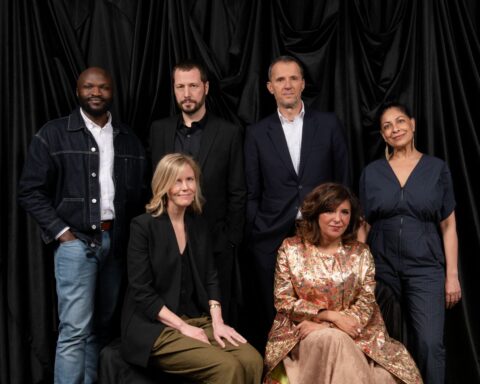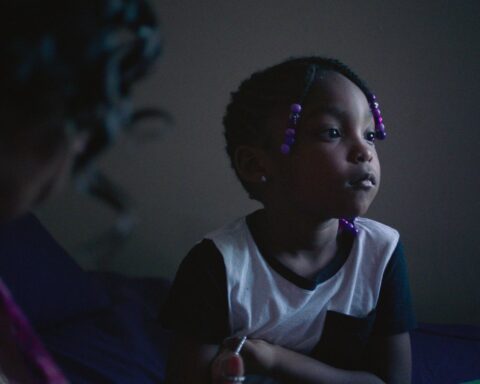POV is pleased to present a translation of Martin Delisle’s ‘Québec: l’incontournable documentarie’ from The Stories We Tell.
Undeniably, the province of Quebec has created its own particular niche in the history of documentary cinema. The advent of what has been called “direct cinema” in the late fifties transformed quite dramatically how films were shot and the manner directors in which approached their subjects. However, it must not be forgotten that a long process preceded this aesthetic. Moreover, the latter was transformed by a new generation of filmmakers, certainly very aware of what it owed to direct cinema, but also wanting to stand out in a world transformed by new technologies.
Many historians date the beginnings of documentary cinema in Quebec in the 1920s, but in doing so they neglect an important figure: the distributor, producer and director Léo-Ernest Ouimet. On January 1, 1906, he opened the Ouimetoscope, considered to be the first real movie theater in Montreal, where the public went in droves to see what were then called “animated images”. In the same year, Ouimet began shooting short films, first on his family, then on major events that stood out in the province of Quebec between 1907 and 1919, such as the collapse of the Quebec Bridge, the major fire in Trois-Rivières, the Eucharistic Congress of Montreal and the funeral of Wilfrid Laurier. Ouimet made some 80 films that have all vanished over the years, which is rather unfortunate for they are in effect the first Canadian film newsreels.
Undoubtedly, direct cinema made it possible to draw a clear and never-before seen portrait of the French-Canadian* society of the 1960s. However, two priests-filmmakers, Albert Tessier and Maurice Proulx had already given the public an image of life, mostly of rural Quebec between 1920 and 1950, in films that can be catalogued under the category of “ethnographic cinema”.
Mgr. Albert Tessier obtains a 16-mm camera and a projector around 1920. He undertakes to film religious events, the land and its inhabitants.in addition to nature which remains his passion and his main subject. He works alone and at his own expense. He himself edits his films and presents them while commenting them in parish halls or church basements. His opus, which amounts to some 70 films, is essentially considered an educational tool. In 1980 the Parti Québécois government sets up a Quebec prize to honor a career in cinema, and names it after Albert Tessier.
Father Maurice Proulx understands the use of cinema as a teaching tool while studying at Cornell University in the 1920s. Just like Mgr. Tessier, he shoots in 16-mm and documents as early as 1934 the colonization of the Abitibi region, glamourizing it to attract new settlers. In 1939, he directs En pays pittoresque: un documentaire sur la Gaspésie, which is considered to be the first feature-length sound Canadian documentary. When the Government of Quebec creates in 1941 the Service de ciné-photographie de la province de Québec, Proulx practically becomes the designated filmmaker for the many sponsored films that are produced by this institution under various governments. His work, composed of 51 documentaries, deals with three main themes: religion, the land and tourism.
The films of Tessier and Proulx make a case for the beauty and the strength of a young and still largely virgin land, seeking to grow and to prosper. In their respective ways, they draw an earnest portrait of Quebec and its inhabitants of their time.
A constant evolution
In 1956, a new player appears in the cinematic landscape of the province of Quebec: the National Film Board of Canada. Since its founding in 1939 by John Grierson, which uses it a tool for propaganda during the war, this government-run production institution was located in Ottawa and was essentially managed by Anglophones. The Francophone filmmakers felt quite lost in an environment where the cultural vision was very far from theirs, and the content of the films did not reflect the French-Canadian reality. They fought for several years to create their own works in French. In September 1956, the NFB opens its doors in Montreal and, in 1957, the French production studio finally comes into being under the direction of Jacques Bobet. To bring in new blood, young filmmakers such as Fernand Dansereau, Léonard Forest, Claude Jutra and Pierre Patry are hired. Rapidly, French production gains momentum and confidence.
In the early 1950s a new documentary approach is put into practice by some of the NFB filmmakers. Under the aegis of Tom Daly, filmmaking breaks away from the constraints of studio shooting. With their portable cameras, Colin Low, Wolf Koenig, Roman Kroitor and Terence McCartney-Filgate, to name but a few, are not afraid to get closer to ordinary people in their daily living environment. This new cinematic form, Candid Eye, leads to the making of very human and spontaneous films primarily intended for television.
A few French-Canadian filmmakers, amongst them Michel Brault, worked on some of the Candid Eye films. A new wind is blowing at the NFB, filled with hope and a spirit of innovation. The flood gates are now open. Michel Brault, Gilles Carle, Jacques Godbout, Gilles Groulx, Claude Jutra, Arthur Lamothe, Pierre Perrault and others begin their brilliant careers at the NFB. The genre “direct cinema” takes off. The short film Les raquetteurs, directed by Michel Brault and Gilles Groulx in 1958, undoubtedly serves as proof of its emergence and that of a cinematographic form that has evolved in line with the aesthetics of Candid Eye. The bold approach of these young directors dramatically challenges the traditional documentary form. The common people are finally given their voices, as evidenced in 1963 in Pour la suite du monde, co-produced in Isle-aux-Coudres by Perrault and Brault and dealing with the recreation of the porpoise fishing tradition. This major work remains in 2017 a beacon of Quebec cinema.
The form of direct cinema also becomes a medium for social and political denunciation as demonstrated by On est au coton. This film about the textile industry in Quebec – also a seminal work in the history of cinema in Quebec – is shot by Denys Arcand between 1968 and 1970. This politically-charged documentary has its director suffer the wrath of higher management at the NFB who censor the work and releases a watered-down version. It is not until 1976 that the institution puts the original version of the film into circulation. Over the years, the NFB’s management will discard several films that it considers too virulent.
Pierre Patry is part of these filmmakers whose works are questioned. He leaves the NFB in 1964 and attempts to revive the private documentary industry by founding the production company Coopératio. It only lasts five years due to lack of proper funding. Many of the pioneers of the NFB French production follow Patry’s path, including Claude Jutra, Jean-Claude Labrecque and Arthur Lamothe. Some alternate between directing works in the private sector and for government agencies such as the NFB and the Office du film du Québec, for which Labrecque makes the unforgettable documentary La Visite du général de Gaulle au Québec in 1967. Most of those who leave the NFB engage in directing feature films. Interestingly, one can find traces of the direct cinema form in the feature films of these directors, a clear sign that this genre has made an important imprint.
Women directors in the spotlight
Among the young Francophones who enter the NFB after the creation of the French production studio is Anne-Claire Poirier. Through her presence women’s subjects find their place in documentaries from Quebec, as evidenced by her first feature, De mère en fille (1967). This film paves the way for a generation of young women directors and screenwriters to whom the NFB opens its doors in 1972 by creating the En tant que femmes series. These include Louise Carré, Mireille Dansereau, Hélène Girard and Aimée Danis. At the same time, other women’s voices rise in the private sector, among others those of Sophie Bissonnette, Sylvie Groulx and Joyce Rock, who make films that clearly state their feminism. Their works finally allow to project a sometimes raw but earnest light on social and political issues that their male colleagues do not think or do not dare to approach. Thus, Une histoire de femmes (Sophie Bissonnette, Joyce Rock and Martin Duckworth, 1980) presents the INCO workers strike in Sudbury from the point of view of the wives who have created their own support committee.
Since the beginning of the 1970s, women have moved into the realm of the documentary in Quebec. In this area, they seem to outnumber their male counterparts. The latter prefer and, by appearances, are strongly encouraged by producers and funding agencies to focus on the making of feature films. However, through the films of Paule Baillargeon, Céline Baril, Marquise Lepage, Tahani Rached and many others, Quebec cinema has been enriched by an original vision far from clichés, with portraits of people or society drawn with the sensibility of each one of these filmmakers. It should be noted that Monique Simard, associated with Productions Virage between 1999 and 2006 – and now the head of the provincial cultural funding agency Société de développement des entreprises culturelles du Québec – strongly contributed to the career of several women filmmakers by producing their films.
A voice from within
Around 1980 there is a sharp decline in Quebec film production, both in fiction and documentary. This situation, which is mainly due to economic problems, will last about ten years.
The 1990s bring in a new generation of independent documentary filmmakers. The advent of digital technology makes filming easier. The documentary becomes an instrument of political and social denunciation.
Thus, Garry Beitel is particularly interested in depicting communities and individuals: in Bonjour! Shalom! (1991), he brings to light the serious disputes between the Hassidic and Francophone communities in a Montreal neighborhood. Bernard Émond’s training in anthropology serves as a basis for his films as in Ceux qui ont le pas léger meurent sans laisser de traces (1992) that paints with a lot of human dignity the portrait of an ordinary 76 year-old man found dead in a street. Social justice is at the heart of the films of Magnus Isacsson, a filmmaker who does not mince words and does not balk at the idea of twice tackling the McDonald’s chain, as he demonstrates in Un syndicat avec ça ? (1999) and Maxime, McDuff et McDo (2002). Sylvain L’Espérance focuses on problems caused by globalization, as proven in his films shot in Africa in the 2000s. In November 2016, he premiered at the Montreal International Documentary Festival (RIDM), Combat au bout de la nuit, a four-hour film shot over four years focusing on the economic deterioration in Greece: a difficult film, yet lightened with the tinge of poetry that is the constant trademark of the style of this filmmaker.
At the same time, some documentary films turn inward and take more of an intimate tone, like those of Lucie Lambert who speak with great sensitivity of the people living on Quebec’s North Shore. For example, Paysage sous les paupières (1996) generously gives the floor to a few women from a small village in this remote region of the province. Catherine Martin distinguishes herself with her cinematographic writing tinged with a certain contemplative slowness. This form is particularly obvious in L’esprit des lieux shot in the Charlevoix region in 2006. This sober elegy describes the constant beauty and strength of nature in that region and is a vibrant tribute to the resilience of its people. As for André-Line Beauparlant, her goal is to get as close as possible, without any form of prejudice to the people she films, as demonstrated in Panache (2006), a humor-tinged portrait of six hunters of the Abitibi region.
This portrait of Quebec documentary cinema would be incomplete if EyeSteelFilms were not mentioned. This company was founded in the 1990s by Daniel Cross to produce his films on the homeless in Montreal. The topic of social change clearly represents the signature of EyeSteelFilms’ productions. A title that stands out among the many successes of this production company is Yung Chang’s Up the Yangtze shot in China in 2007. In addition to being a huge box-office success, it won numerous awards including the Genie for Best Documentary in 2009.
A promising new generation
A fundamental difference becomes evident in the dealings with the protagonists between the directors of the 1950s and 1960s and those of today. Thus, in some films of the direct cinema period, there sometimes seems to be a lack of personal connection with the people that are being filmed, whereas new-generation filmmakers are much more involved and become part of their films. They no longer hide behind the camera. They do not hesitate to show themselves on the screen and they forge a much closer connection with the people they are interested in.
The Abenaki filmmaker Alanis Obomsawin, who completed her forty-ninth film at the NFB in 2016, stands out as the pioneer of Aboriginal cinema in Quebec. Her films, such as Kanehsatake, 270 years of resistance (1993), bring to light the problems and conflicts faced by indigenous peoples. She inspired and encouraged the emergence of a new generation of filmmakers who now bring a new and important dimension to the world of the Quebec documentary. Several other young Aboriginal creators come from the Wapikoni mobile program, created in 2004 by filmmaker Manon Barbeau, which offers audiovisual creation workshops in indigenous communities of Quebec. Moreover, in January 2017, the prestigious Sundance Film Festival in Utah presented the short film My Father’s Tools, produced by Wapikoni Mobile and directed by Heather Condo, a member of the Mi’kmaq community of Gesgapegiag in the Gaspe Peninsula.
Now, in 2017, documentary cinema has regained its reputation in Quebec. Of course, its funding is never sufficient. But this form is made of female and male voices, of all origins, all more unique and personal than the others, which never cease to enrich it. New technologies have led to interactive creation and the web documentary, the production and distribution of which are constantly gaining scale. This form of interactive expression allows for a non-linear form of writing and narration, far removed from the structures and constraints of conventional production. In Quebec, the television networks and the NFB have been involved for some years in this process and the public has taken to them. Recently, Hélène Choquette distinguished herself particularly in this field directing Unité 9 – Webdocumentaire and PIB : l’indice humain de la crise économique canadienne. Finally, new technologies have also led to the development of virtual reality that combines the documentary form and immersive multimedia, creating a universe that appeals to all of the viewers’ senses.
All this suggests that the death of documentaries in Quebec will not happen anytime soon, both in its conventional form and in that of new technologies that are constantly evolving. With a new generation of creators who are just as curious and inventive as the pioneers of this form of filmmaking, but also conscious of their heritage and benefiting from extraordinarily accessible technical means, the documentary will still offer the viewer rich moments of entertainment and discovery of unknown people and worlds.
For more stops on the POV cross Canada documentary road trip, visit: British Columbia, Alberta, Saskatchewan, Manitoba, Ontario, Atlantic Canada, and the North.
*At the identity level, the term “Québécois” replaced that of “Canadian French” in the late 1960s.










